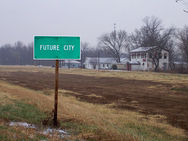Topic of the week: Greater Greater 2024

Photo by Joe on Flickr.
Wednesday marks the start of 2014, but what about further into the future? We asked our contributors what they hope to be writing and reading about on Greater Greater Washington in 10 years.
Dan Reed: I’d like to write about how the region’s ethnic enclaves, from Langley Park to Annandale, have become the new hot spots, drawing investment from around the globe as the cool kids finally realize there’s a big world outside DC, and it’s got much better food. Meanwhile, the Rockville Metro station gets renamed “Chinatown.”
Jim Titus: I hope to read that that Metropolitan AME complains about DDOT’s insensitivity to churches, while the city makes excuses. Church officials complain that CaBi needs to completely empty its 60-bike dock early on Sundays, to prevent the dock from exceeding capacity at the 11:00 AM service.
But DDOT says the real problem is that the new “trikeshare” three-wheelers used by most elderly parishioners each take up two spaces. Church officials concede that the dock never fills at the 7:45 service, which is generally attended by younger members.
Michael Perkins: Goal for the next five years is for DC to take the experience in San Francisco to heart and get serious about managing their curbside parking. Adjust hours and prices to ensure people can find a space if they’re willing to pay what it’s worth.
Ben Ross: Construction of a new Metro line through downtown DC, and new rail lines in the suburbs. And a reorientation of the Montgomery and Prince George’s transportation departments, like DC and Arlington, to operate urban complete streets rather than suburban highways.
Canaan Merchant: 1) Hopefully I’ll be reading about construction on a number of new transit lines. 2) Hopefully we’ll see so many people on bikes that we’ll need to discuss how to handle bicycle congestion. 3) How the city has adapted under new buildings that have broken the current height limit. 4) What the city has planned for an RFK site that is now focused on providing new housing/retail for the city and not more stadiums and parking lots. 5) How the Columbia Pike streetcar has aided in transforming the corridor and led to calls for streetcar expansion throughout Northern Virginia.
Chad Maddox: How the region has successfully absorbed many more residents while simultaneously managing to keep housing relatively affordable. Also, how the District has become a national model for its efforts to eliminate concentrated poverty and residential segregation in its borders.
Tracey Johnstone: That better coordination among local transit agencies, combined with the implementation of free transfer among subway, light rail, bus, and streetcar increased transit usage by over 25%.
Adam Froehlig: In a controversial effort to address chronic bike congestion on the MVT and the 14th St Bridge path, NPS and DDOT implement all-electronic bicycle tolls. A local bike commuter is quoted in the news as saying it will force him to switch to driving while another complains that the revenues will go to the private collector and WMATA instead of to path and bridge repairs.
And after years of false starts, the District finally implements a mileage tax. The effort is seen as a colossal failure as non-DC-registered cars are exempt and the elimination of the gas tax prompts Maryland drivers to suddenly flood DC streets such as Benning Road and Georgia Ave to take advantage of the cheaper DC gas.
Neil Flanagan: I’d like to hear Montgomery officials getting anxious about how successful Prince George’s Smart Growth program has been. That it’s putting pressure on DC to drop rents, but won’t someone think about the historic Greenbelt gas station that’s going under?
Also, “Daddy, what’s a Millenial?”
